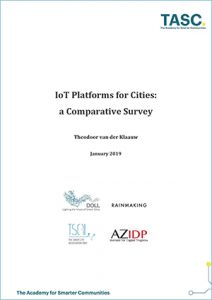 A report developed by TASC.
A report developed by TASC.
Thousands of city governments all over the world are currently running their first Internet of Things (IoT) smart city projects. As they do so, software platforms get introduced that help manage data flows, support application development, and provide basic analytics. However, the IoT platform selection process is challenging and differs per community – that is if the selection process exists at all, with many customers of IoT solutions accepting the vertically integrated software that comes with a given vendor, putting cities at risk of vendor lock-ins. Some city governments prefer to collaborate with smaller IoT platform vendors that can provide strong support and appear sufficiently agile to customize to local requirements and ecosystems better and faster; other cities prioritise the scalability, end to end security, and usability offered by larger technology vendors. Either way, most public and many private organizations emphasize the need for an open ecosystem approach.
To create an improved understanding among stakeholders, this comparative study evaluates different IoT platform solutions in terms of integration & interoperability, functional capabilities, business & delivery models, as well as partner strategies & ecosystem.